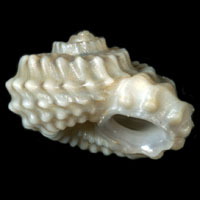|
< Previous family introduction |
|
|||||
 |
Family Tornidae Tornids
|
|||||
|
The family Tornidae was previously known as Vitrinellidae, but Tornidae is now accepted as an earlier name. In the discussion of this family in The Southern Synthesis in 1990, Ponder & de Keyzer summarised the state of knowledge as ",This 'family' is in such a state of taxonomic chaos that any discussion of even the genera present in Australia is premature". As there has been no substantial publications on the family since then, this is still the situation. Species presently assigned to Tornidae occur in temperate and tropical seas worldwide. There are currently 42 species recorded from Australia, mostly from the tropical north. In NSW there are 8 species. The NSW species of this family are notable for their diversity. Species vary in size from 1 mm to 10 mm;, in sculpture from glassy smooth to solid and heavily nodulose; in habitat from intertidal in sheltered bays to living on wood at 384 m. About the only character the shells have in common is a moderate to low conical form with an open umbilicus, but even this last feature is disguised in one species where the umbilicus has a secondarily callus. Family Referece There is no literature that deals with the Australian fauna in a systematic manner. In the past the species have been scattered across several families. Laseron (1954), in his paper on the NSW Liotidae, included six of the species in that family, as he worked from empty shells alone.
Coverage In addition to the species detailed, there is one further species:
Identification Notes Beyond a moderately low or low conical shell with widely open umbilicus there are no shell features that reliably place species in this family. |